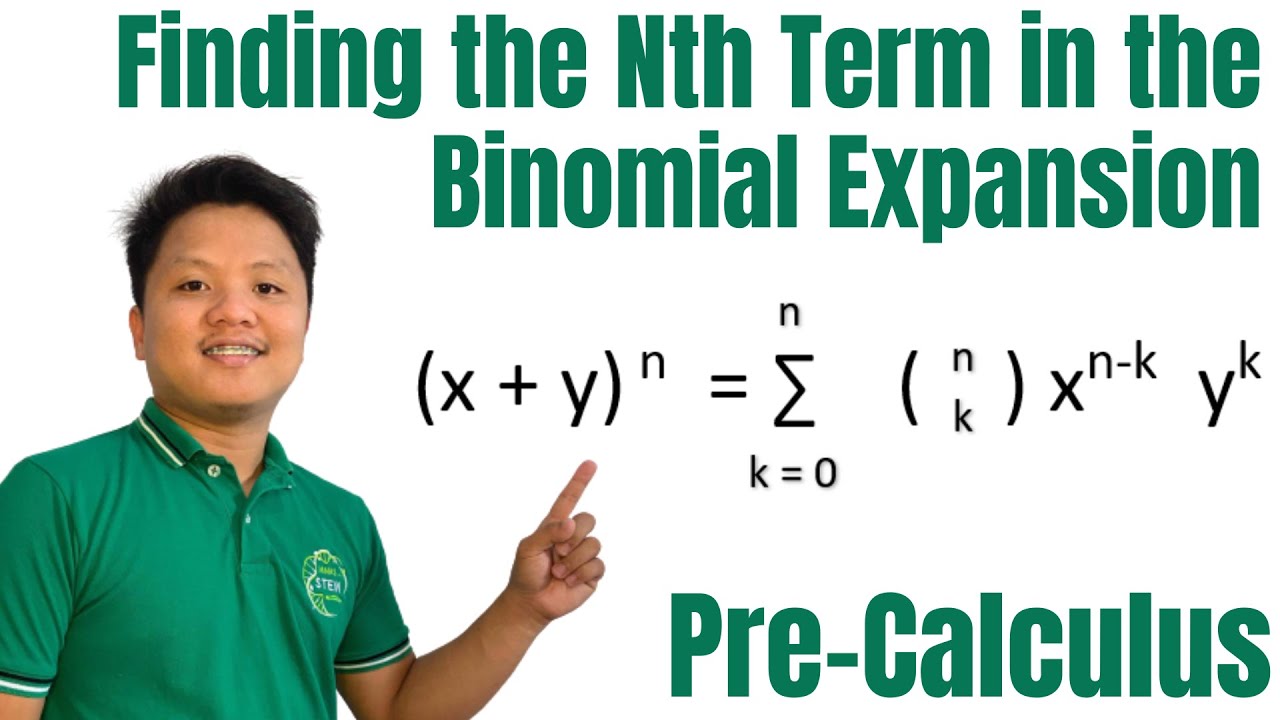Binomial theorem combinatorics connection | Algebra II | Khan Academy
TLDRThis video script delves into the combinatorial nature of multiplying binomials, specifically focusing on the expansion of (a + b)^3. The presenter uses a colorful, step-by-step approach to illustrate the process, emphasizing the importance of each term in the expansion. By meticulously multiplying each combination of 'a' and 'b', the video reveals how binomial coefficients emerge naturally from the process. The script aims to provide an intuitive understanding of why these coefficients are present and how they relate to the concept of combinations, ultimately offering a deeper insight into the binomial theorem.
Takeaways
- 📚 The video aims to provide an intuitive understanding of why multiplying binomials involves combinatorics and the role of binomial coefficients.
- 🎨 The use of multiple colors in the explanation is intentional to help illustrate the process and make it easier to follow.
- 🔢 The script demonstrates the multiplication of (a + b) to the third power using the distributive property and emphasizes the importance of the order of operations.
- 📉 The process involves breaking down the multiplication into smaller parts and multiplying each term step by step.
- 🌈 The colors used for each term help to visually distinguish between the different parts of the binomial being multiplied.
- 🔍 Each term in the expansion is a product of three numbers, with one from each of the three binomial expressions (a + b).
- 🧩 The expansion shows every possible combination of choosing 'a' or 'b' from each of the three binomial expressions.
- 📈 The script explains how the coefficients in the binomial expansion, such as 3a^2b, relate to the number of combinations for choosing 'a's and 'b's.
- 🤔 The video encourages viewers to think about the process as picking terms from each binomial expression, highlighting the connection to permutations and combinations.
- 📝 The explanation concludes by relating the coefficients in the binomial expansion to the concept of 'choose' from combinatorics, such as 3 choose 2 for the a^2b term.
- 🌟 The overall goal is to provide a deep intuition for why combinations are involved in the binomial theorem and how they relate to the expansion of a binomial to a certain power.
Q & A
What is the main topic of the video?
-The main topic of the video is to explain the intuition behind why multiplying binomials involves combinatorics and the role of binomial coefficients in the process.
What is the binomial being multiplied in the video?
-The binomial being multiplied in the video is (a + b) to the third power.
How does the video use colors to aid understanding?
-The video uses colors to distinguish between different terms and factors in the binomial expansion, making it easier to track and understand the process.
What is the purpose of using the distributive property in the video?
-The distributive property is used to expand the binomial (a + b)^3 step by step, showing each multiplication and how the terms are generated.
How many terms are there in the expansion of (a + b)^3 before simplification?
-There are eight terms in the expansion of (a + b)^3 before any simplification.
What does the video suggest about the relationship between the number of terms and the binomial coefficients?
-The video suggests that the number of terms in the expansion corresponds to the binomial coefficients, which represent the number of ways to choose 'a' or 'b' from each set of terms.
How does the video explain the term 'a squared b' in the expansion?
-The video explains that 'a squared b' can be obtained in three different ways by choosing two 'a's and one 'b' from the three sets of (a + b), which corresponds to the binomial coefficient '3 choose 2'.
What is the significance of the binomial coefficient '3 choose 1' in the video?
-The binomial coefficient '3 choose 1' signifies the number of ways to choose one 'a' and two 'b's from the three sets of (a + b), which is used to determine the coefficient for the 'ab squared' term.
How does the video relate the binomial expansion to permutations and combinations?
-The video relates the binomial expansion to permutations and combinations by showing that each term in the expansion represents a unique way of choosing 'a' or 'b' from each set of (a + b), which is a combinatorial problem.
What is the final simplified form of the binomial expansion shown in the video?
-The final simplified form of the binomial expansion is not explicitly shown in the transcript, but it is implied that it would follow the pattern of the binomial theorem, with terms like a^3, a^2b, ab^2, and b^3, each multiplied by the appropriate binomial coefficient.
Outlines
📚 Introduction to Binomial Multiplication and Combinatorics
The video begins with an introduction to the concept of multiplying binomials and the role of combinatorics in the process. The speaker uses colors to visually distinguish between different terms and to illustrate the multiplication of (a + b)^3 step by step. The goal is to show why binomial coefficients appear in the expansion and to provide an intuitive understanding of the process.
🌈 Detailed Expansion of (a + b)^3
In this section, the speaker meticulously expands the expression (a + b)^3 using the distributive property, emphasizing the importance of each term and how they are derived. By multiplying the binomial by itself three times and carefully tracking the colors, the speaker demonstrates that each term in the expansion results from choosing either 'a' or 'b' from each instance of the binomial, resulting in a total of eight terms.
🔍 Understanding the Role of Combinations in Binomial Expansion
The speaker delves into the combinatorial aspect of the binomial expansion, explaining how each term in the expansion of (a + b)^3 corresponds to a specific combination of 'a's and 'b's. The explanation focuses on the number of ways to choose 'a' or 'b' from the three instances of the binomial, leading to the realization that the coefficients in the expansion are the same as those found in the binomial theorem. This part of the video aims to clarify why the binomial coefficients appear as they do and to provide a deeper understanding of the underlying combinatorial principles.
🎯 Conclusion and Summary of Binomial Theorem's Combinatorial Connection
The final paragraph wraps up the video by summarizing the insights gained from the detailed expansion of (a + b)^3. The speaker reiterates the connection between the binomial theorem and combinatorics, highlighting how the coefficients in the expansion are derived from combinations of 'a's and 'b's chosen from the three instances of the binomial. The video concludes with a reaffirmation of the importance of understanding these combinatorial principles to grasp the full intuition behind the binomial theorem.
Mindmap
Keywords
💡Binomials
💡Combinatorics
💡Binomial Coefficients
💡Distributive Property
💡Permutations and Combinations
💡Color Coding
💡Expansion
💡Coefficients
💡Binomial Theorem
💡Intuition
💡Simplification
Highlights
The video aims to provide intuition behind the binomial theorem and combinatorics in multiplying binomials.
The presenter uses multiple colors to illustrate the process, emphasizing their significance in the explanation.
The multiplication of (a + b) to the third power is demonstrated using the distributive property.
Each color represents a different instance of the binomial (a + b), aiding in visualizing the multiplication.
The process involves tedious multiplication, but it is crucial for understanding the outcome.
The expansion of (a + b)^3 is shown step by step, with each term being carefully calculated.
The multiplication results in terms with three numbers, each from a different color group.
The presenter explains that each term in the expansion is a product of choosing either 'a' or 'b' from each group.
The total number of terms in the expansion equals the number of ways to choose 'a' or 'b' from the three groups.
The simplification of the expansion reveals terms like a^3, a^2b, and ab^2, each with specific coefficients.
The coefficient '3' in front of a^2b is explained as 3 choose 2, linking to the concept of combinations.
The presenter explores the symmetry and the combinatorial aspect of the binomial expansion.
The binomial theorem's definition is related to the process of choosing 'a' or 'b' in the expansion.
The concept of '3 choose 1' and '3 choose 2' is used to explain the coefficients of the expanded terms.
The presenter concludes by summarizing the binomial expansion in terms of combinations.
The video provides a deep intuition for why combinations are involved in the binomial theorem.
The final message is that the binomial expansion can be viewed as choosing 'a' or 'b' in different combinations.
Transcripts
5.0 / 5 (0 votes)
Thanks for rating:





